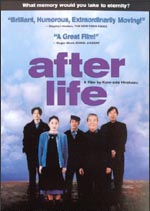
AFTER LIFE
Reviewed February 11th, 2002 by David Nusair
After Life features a concept so weird, that unless youíre willing to just go with it, itís unlikely youíll enjoy the film too much (like me).
As the film opens, a group of around 20 people have just arrived at what can best be described as a run-down schoolhouse. Theyíre quickly informed that they are, in fact, dead and have been brought to this place to perform their final task before moving on. This task involves choosing one memory to take with them to the great beyond, where theyíll relive that moment for the rest of eternity. Helping them to remember is a staff of employees, former human beings that spend their days cajoling long-forgotten memories out of the recently departed. Finally, once the memory has been chosen, a film crew of sorts is assembled to film the recollection as best they can, for an eventual screening for the soon-to-be heavenward bound.
After Lifeís premise is incredibly unappealing Ė really, who wants to relive the same moment over and over Ďtil the end of time? Ė which makes the movie almost impossible to relate to. And the structure of the movie doesnít help matters, either. Much of the flick has been shot documentary-style, with the various dead folks talking about their lives and their memories. While some of this is interesting, this much dialogue about nothing by people we couldnít care less about eventually gets tedious.
And if that wasnít bad enough, the whole concept is somewhat confusing as well. After the dead people have selected their memory, a crew quickly gets to work assembling a set thatís supposed to resemble the picture thatís in their mind. For what purpose? Iím still not entirely sure. The dead are assembled (after each memory has been filmed) in a screening room and forced to watch a poorly reconstructed version of their chosen remembrance Ė after which they are apparently sent to their final destination. This whole idea of re-filming something thatís already occurred for each individual is bizarre and is never explained. Why canít each person move forward with the memory thatís already in their mind?
After Life does contain some interesting ideas and genuinely moving emotional revelations, but itís too little too late. However, most critics seemed to love this movie, so I could have just missed the whole point. But really, this is a potentially intriguing concept undone by flawed execution.
Audio: After Life is presented in Japanese with a 2.0 soundtrack. Itís effective, though not impressive. There arenít any instances of spatiality, but the dialogue is relatively clear Ė though somewhat muffled.
This non-anamorphic transferís ratio is less than 1.85:1. This is a fairly good transfer, though there are a few instances of film-related artifacts. The Japanese subtitles are burned into the image, which is kind of odd.
Extras: You get some production notes, a message from the director, a history of New Yorker video, two trailers for the film (one English and one Japanese Ė without subtitles), and one trailer for the directorís Maborosi.
Conclusion: After Life might appeal to you as long as youíre willing to accept the ludicrous premise.
Please help support our site by buying this DVD title
through this link. Thank you
kindly.
|


 Purchase
This DVD Purchase
This DVD
Story / Content

Audio

Video

Extras

|